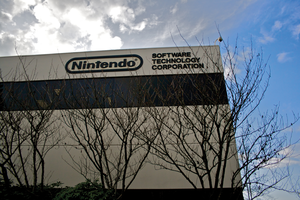
Nintendo Co., Ltd. is a Japanese multinational video game company headquartered in Kyoto. It develops, publishes and releases both video games and video game consoles.

The Wii is a home video game console developed and marketed by Nintendo. It was released on November 19, 2006 in North America, and in December 2006 for most other regions of the world. It is Nintendo's fifth major home game console, following the GameCube and is a seventh-generation console alongside Microsoft's Xbox 360 and Sony's PlayStation 3.

Mr. Game & Watch is a 2D generic stick figure-styled silhouette character, created by Nintendo as an amalgamation of various characters that appeared in the Game & Watch handheld consoles. He was created by Gunpei Yokoi, with an intention of representing the Game & Watch collection, as the consoles had no main mascot, rather characters designed for the minigames. He debuted in Ball from Game & Watch. Mr. Game & Watch has appeared as a cameo in several other Nintendo games, such as Donkey Kong Country Returns, WarioWare: Touched!, Rhythm Heaven Fever and Super Mario Odyssey.
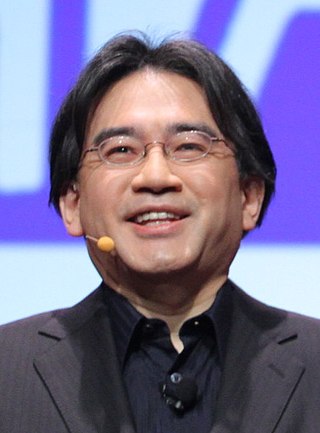
Satoru Iwata was a Japanese businessman, video game programmer, video game designer, and producer. He was the fourth president and chief executive officer (CEO) of Nintendo from 2002 until his death in 2015. He was a major contributor in broadening the appeal of video games by focusing on novel and entertaining games rather than top-of-the-line hardware.
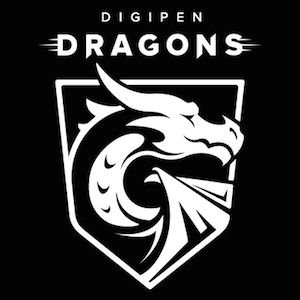
DigiPen Institute of Technology is a private for-profit university in Redmond, Washington. It also has campuses in Singapore and Bilbao, Spain. DigiPen offers bachelor's and master's degree programs. It also offers summer programs for students in grades K-12, online courses, and year-long high school programs.
Retro Studios, Inc. is an American video game developer and subsidiary of Nintendo based in Austin, Texas. The studio is best known for its work on the Metroid Prime and Donkey Kong Country series, and has contributed to several other Nintendo-developed projects, such as Mario Kart 7.

Factor 5 GmbH is an independent software and video game developer. The company was co-founded by five former Rainbow Arts employees in 1987 in Cologne, Germany, which served as the inspiration behind the studio's name.

Nintendo Entertainment Analysis & Development Division, commonly abbreviated as Nintendo EAD and formerly known as Nintendo Research & Development No.4 Department, was the largest software development division within the Japanese video game company Nintendo. It was preceded by the Creative Department, a team of designers with backgrounds in art responsible for many different tasks, to which Shigeru Miyamoto and Takashi Tezuka originally belonged. Both served as managers of the EARD studios and were credited in every game developed by the division, with varying degrees of involvement. Nintendo EAD was best known for its work on games in the Donkey Kong, Mario, The Legend of Zelda, F-Zero, Star Fox, Animal Crossing, Pikmin, and Wii series.

Next Level Games, Inc. is a Canadian video game developer owned by Nintendo based in Vancouver. Founded in October 2002, Next Level Games specializes in creating console video games. Their first project was NHL Hitz Pro, which was published by Midway Games in 2003. The company is best known for its work with Nintendo, the Mario Strikers games and Punch-Out!! for the Wii, Luigi's Mansion: Dark Moon and Metroid Prime: Federation Force for the Nintendo 3DS, and Luigi's Mansion 3 for the Nintendo Switch.
Project H.A.M.M.E.R. was a beat 'em up video game in development by Nintendo Software Technology for the Wii. The team's other projects included Metroid Prime Hunters, 1080° Avalanche, and Wave Race: Blue Storm. Project H.A.M.M.E.R. was originally announced at E3 2006. No information regarding the game has been released to the public or media since the game's original announcement. Rumors began circulating in mid-June 2007 that the game was not going to be released, and that the development team had gone to work on other games. Nintendo confirmed at E3 2007 that development was on hold. Beth Llewelyn, senior director of public relations at Nintendo of America, made a point to note that despite the game not being a focus of Nintendo’s, Project H.A.M.M.E.R. "may come back" in the future. A report revealed that the game was cancelled in 2009 due to creative internal conflicts at Nintendo Software Technology.

Nintendo Research & Development No. 2 Department, commonly abbreviated as Nintendo R&D2, was a Japanese team within Nintendo that developed software and peripherals. While usually occupied in system operating software and technical support, the team would come back to early development in the 1990s where several new designers got their start at game development, the most famous being Eiji Aonuma who developed Marvelous: Another Treasure Island.

Animal Crossing is a social simulation video game series developed and published by Nintendo. The series was conceptualized and created by Katsuya Eguchi and Hisashi Nogami. In Animal Crossing, the player character is a human who lives in a village inhabited by various anthropomorphic animals and can do various activities like fishing, insect catching, and fossil hunting. The series is notable for its open-ended gameplay and use of the video game console's internal clock and calendar to simulate real passage of time.

A Mii is a customizable avatar used on several Nintendo video game consoles and mobile apps. The name Mii is a portmanteau of "Wii" and "me", referring to them typically being avatars of the players. Miis were first introduced on the Wii console in 2006 and later appeared on the DS, 3DS, the Wii U, the Switch, and various apps for smart devices such as Miitomo. Miis can be created using different body, facial and clothing features, and can then be used as characters within games on the consoles, either as an avatar of a specific player or in some games portrayed as characters with their own personalities. Miis can be shared and transferred between consoles, either manually or automatically with other users over the internet and local wireless communications.

Nintendo Software Planning & Development Division, commonly abbreviated as Nintendo SPD, was a Japanese research, planning and development division owned by Nintendo and housed inside the Nintendo Development Center in Kyoto, Japan. The division had two departments: Software Planning & Development Department, which primarily co-produced games with external developers; and Software Development & Design Department, which primarily developed experimental and system software. The division was created during a corporate restructuring in September 2003, with the abolition of the Nintendo R&D1 and Nintendo R&D2 departments.
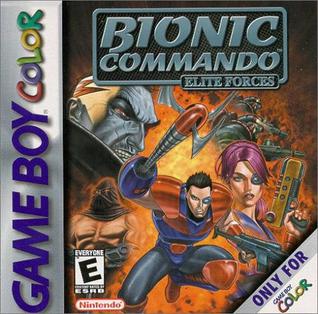
Bionic Commando: Elite Forces is a video game released in 2000 for the Game Boy Color. Though the game is part of the Bionic Commando series of games by Capcom, Elite Forces is the only game in the series to be published by Nintendo, and was the first title to be developed by its Redmond-based first-party studio Nintendo Software Technology. It is the sequel to the Game Boy version of Bionic Commando, which launched worldwide in 1992, though it was only ever released in North America and Australia; however, in November 2014, the game launched for the Nintendo 3DS Virtual Console service in Europe, again published by Nintendo.
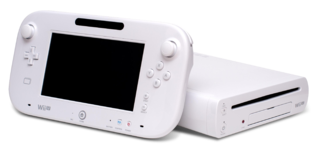
The Wii U is a home video game console developed by Nintendo as the successor to the Wii. Released in late 2012, it is the first eighth-generation video game console and competed with Microsoft's Xbox One and Sony's PlayStation 4.
Amiibo is a toys-to-life platform by Nintendo, which was launched in November 2014. It consists of a wireless communications and storage protocol for connecting figurines to the Wii U, Nintendo 3DS, and Nintendo Switch video game consoles. These figurines are similar in form and functionality to that of the Skylanders, Disney Infinity and Lego Dimensions series of toys-to-life platforms. The Amiibo platform was preannounced to potentially accommodate any form of toy, specifically including general plans for future card games. Amiibo use near field communication (NFC) to interact with supported video game software, potentially allowing data to be transferred in and out of games and across multiple platforms.
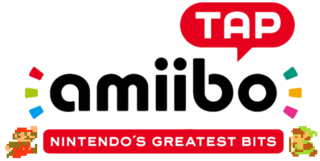
Amiibo Tap: Nintendo's Greatest Bits, known as Amiibo Touch & Play: Nintendo Classics Highlights in the PAL regions, was an application developed and published by Nintendo for the Wii U's Nintendo eShop in 2015. The application was used to play demos of 30 popular Nintendo Entertainment System and Super Nintendo Entertainment System video games by scanning, Amiibo figurines, Nintendo's toys-to-life series of products.

Nintendo Entertainment Planning & Development Division, commonly abbreviated as Nintendo EPD, is the largest division within the Japanese video game company Nintendo. The division focuses on developing and producing video games, mobile apps, and other related entertainment software for the company. EPD was created after merging their Entertainment Analysis & Development (EAD) and Software Planning & Development (SPD) divisions in September 2015.

